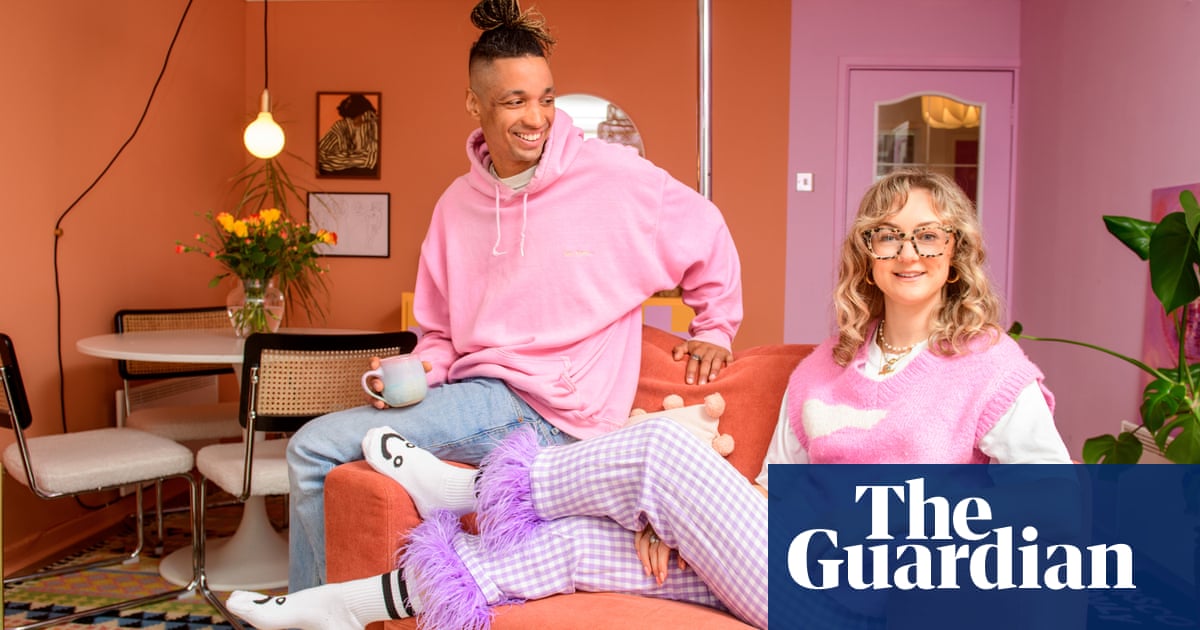The dance pole bang in the middle of Georgie Webster’s living room is one of its less eye-catching features. The lounge has striking pink and peach walls, a sideboard painted in cubes of purple and orange, and an olive-green sofa, all of which come together to create a kaleidoscope of colour.
On paper, it really shouldn’t work, but the 36-year-old artist and interior designer has more than pulled it off. Thousands of other people seemingly agree. Webster is one of a growing number of small-space interior influencers who has had a boom in interest from young renters and first-time buyers looking to spruce up their compact homes.
“People think interior design is just for rich people but it’s very much not. Everyone deserves to have a nice house and you can do things on a much cheaper budget,” said Webster, who runs TikTok and Instagram accounts under the nameGeorgieWebArt.
For many young people, the dream of home ownership is an increasingly fleeting one. Recent analysis by the estate agent Hamptons found that 3.4 million under-45s were renters, a figure that has risen by 149,000 in the past two years. In the same period, this cohort has experienced a collective £3.5bn rent increase, which has made saving up for a house deposit even harder.
Webster is one of the lucky few young homeowners, having bought her flat in Bristol in 2022. Before that, she had rented numerous properties in the city for almost a decade. “I’ve done all the house shares, from chaotic housemates to amazing ones,” she said.
Having a place to call her own has allowed her to express herself with no limitations. Her kitchen is decked from cupboards to floor in peach and her bathroom ceiling is painted sky-blue with white clouds. “Not many landlords would be happy with that,” she said.
Her audience, which she said are mostly aged between 24 and 34, comprises of those living in small homes, including renters who face stricter rules on doing up their properties.
“There are so many good rental hacks now. You can put peel-back tiles and floors down and you can paint if you’re willing to paint it back after,” she said. Some creators have been particularly creative, withoneusing double-sided tape to easily install boutique wallpaper that can be taken down and put up again in another home.
For those who would not dare touch their walls for fear of losing their deposit, Webster has a top tip: “Focus on adding colourful accessories and artwork. Rugs make a massive difference to a room. Go for the biggest rug you can afford because that makes a huge difference.”
Webster’s embrace of colour comes amid a shift away from “millennial grey”, a neutral style that was all the rage until the early 2020s. She believes style is not the only reason behind this change.
“I partly think this is because the world is quite sad at the moment so if your space is happy, then you feel happier. Plus, everyone is struggling a bit for money, people are spending more time at home,” she said.
Other are still stuck with the creative limitations that being a renter brings. Alice Redfearn, 27, has long looked at the high-end interior design featured on Architectural Digest and House & Garden, but living in London, hunkering down in such grand, stately places remains a dream.
Nevertheless, the marketing officer, who runs a TikTok account calledMerakialInteriors, has found a way to bridge the gap. “I think you can have an appreciation for a good taste in interior design but also not be there physically and financially,” she said.
“I thought other people must also be struggling with this, so I kind of started making videos to give advice.”
Originally from County Durham, Redfearn has lived in four properties since moving to the capital. “I‘ve always gone for houses that have good bones, ideally with big windows and tall ceilings,” she said. “Of course, you can only be so picky when you’re looking with friends and you have a small budget.”
For Redfearn, patience is key to making your compact space feel homely and unique. “A lot of the furniture that I have is stuff that was free on Facebook Marketplace or found on the street in good condition that could be cleaned and reused.
“It’s not a fast process either. The house is not going to look exactly how you want it to look immediately, but eventually it will through slowly accumulating furniture, artwork and other things over time,” she said.
She has some foolproof tips to make your temporary abode feel more stately: swap out the curtains – which are often cheap and ill-fitted – for some fancy ones; mix patterns and colours using trinkets and furnishings; and make some clever choices to add some scale.
“If you want your deposit back, you probably aren’t going to be hammering nails into walls,” she said. “You can split the space in two halves by having furniture of all the same height – your table, sofa, and TV. Then, you can have a very large blank space on your wall.”
Redfearn said it was understandable why some rented properties lack colour and personality. “People are quite hesitant to inject time, resource and money into spaces they may not be staying in long-term because of reasons beyond their control,” she said.
But for those who want to turn their homes into havens, despite the limitations, it can be done. “Young people deserve to have a nice home,” says Redfearn.
